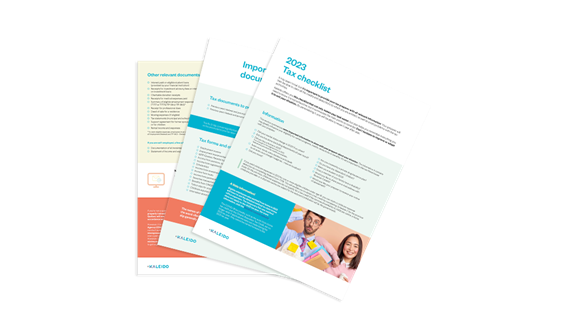How does an RESP affect my income tax return?
Income tax season is fast approaching. At the beginning of the year, a lot of people have questions about how to declare their RESP and the impact of education savings on their tax return. We've put together a series of answers to frequently asked questions about taxes and RESPs to help you make sense of things.

Is the RESP tax deductible?
Registered Education Savings Plan (RESP) contributions are not tax deductible. One of the main advantages of an RESP is that investment income is not taxed as long as it remains in the plan. In other words, your RESP grows tax-free, much like an RRSP or TFSA.
In addition, RESP contributions generate another significant benefit: generous grants from the federal and provincial governments.
In fact, your RESP contributions can be boosted by 30% to 60% through government grants. In Quebec, you could receive up to $7,200 in Canada Education Savings Grant (CESG)up to $3,600 in Quebec Education Savings Incentive (QESI) and $2,000 in Canada Learning Bond (CLB). That's a $12,800 bonus1 that your child could benefit from!
Are registered education savings plans taxable?
The returns from a registered education savings plan are not taxable. An RESP, by definition, is a savings plan that allows you to set money aside and let it grow tax-free.
It is the investment income that will be taxed when the beneficiary withdraws the money from the education savings plan. In fact, when investment income and grants (known as “educational assistance payments ”) are withdrawn from the RESP - to pay for various expenses related to eligible post-secondary education2 (tuition, room and board, etc.), they are added to the taxable income of the beneficiary, not that of the subscriber. In most cases, the young beneficiary is in a lower tax bracket, so they won't have to pay income tax.
On the other hand, contributions can be withdrawn tax-free by the subscriber, who can choose to keep them or pay them to the young person.
It's also worth noting that if RESP contributions exceed $50,000 for life, all excess contributions will be taxed at 1% per month until the excess is withdrawn. If you find yourself in this situation, you can complete the T1E-OVP form online to declare your excess RESP contributions.
Do I have to pay taxes when I close an RESP?
It depends. If, when the RESP is closed, you receive an Accumulated Income Payment (AIP), this amount will be considered income and therefore taxed (at your marginal tax rate, plus a penalty of 12% in Quebec3 and 20% in other provinces).
Note that whatever the reason for closing the education savings plan, not all the money is lost. The amount invested in contributions may be returned to you, under certain conditions4. Government grants, on the other hand, will have to be repaid in full.
To avoid the penalty and defer income tax, you could also transfer the RESP to an RRSP, if you have sufficient RRSP contribution room.
What is an Accumulated Income Payment (AIP)?
The Accumulated Income Payment (AIP) is an option that allows you to withdraw earnings from RESP contributions and/or grants. The AIP allows you to withdraw income from your education savings account before it is closed. However, there are certain conditions5 for requesting an accumulated income payment.

Can't decide between an RESP and an RRSP?
As you probably know, RRSPs offer an immediate advantage by reducing your income tax. RESPs, for their part, also benefit from immediate government grants, grow tax-free, and can allow you to recover your tax-free contributions4 at a later date and reinvest them in your RRSP.
So why not have both? Check out our dedicated page on the subject, which will give you all the information you need on these two smart investments.
Is there a deadline for investing in a registered education savings plan?
There really is no deadline for contributing to your RESP. However, depending on your savings capacity, we recommend that you invest as much as possible before the end of the calendar year (December 31) in order to maximize the government grants you can receive1 for the current year.
What's more, although you can receive grants until the end of the year in which your beneficiary turns 17, you can't recover more than one year's worth of unused grants at a time. In other words, if you delay taking full advantage of government incentives, you risk losing access to these grants for good.
If you'd like to learn more about RESPs and tax returns, we recommend consulting the Government of Canada website. You'll find a lot more information on how RESPs affect taxes, special cases and forms to fill out if necessary.
You can also make an appointment with one of our representatives, who will be happy to explain everything to you.

Need a helping hand with your taxes?
Download our special checklist to help you make sure you don’t forget anything when filing your tax return.
1. Canada Education Savings Grant (CESG) from 20% to 40% and Quebec Education Savings Incentive (QESI) from 10% to 20%. Based on adjusted family net income. The maximum annual CESG payment is $600 and the maximum annual QESI payment is $300. The lifetime maximum per beneficiary is $7,200 for CESG and $3,600 for QESI. Canada Learning Bond (CLB) of up to $2,000 per beneficiary, for a financially eligible child born after December 31, 2003. Certain conditions apply. See our prospectus at kaleido.ca.
2. Certain conditions apply. See eligible post-secondary programs in our prospectus at kaleido.ca.
3. Source: RESP - Accumulated Income Payments.
4. The refund of contributions is made subject to investment risk. Certain conditions apply. See our prospectus at kaleido.ca.
5. See conditions on the Government of Canada website.